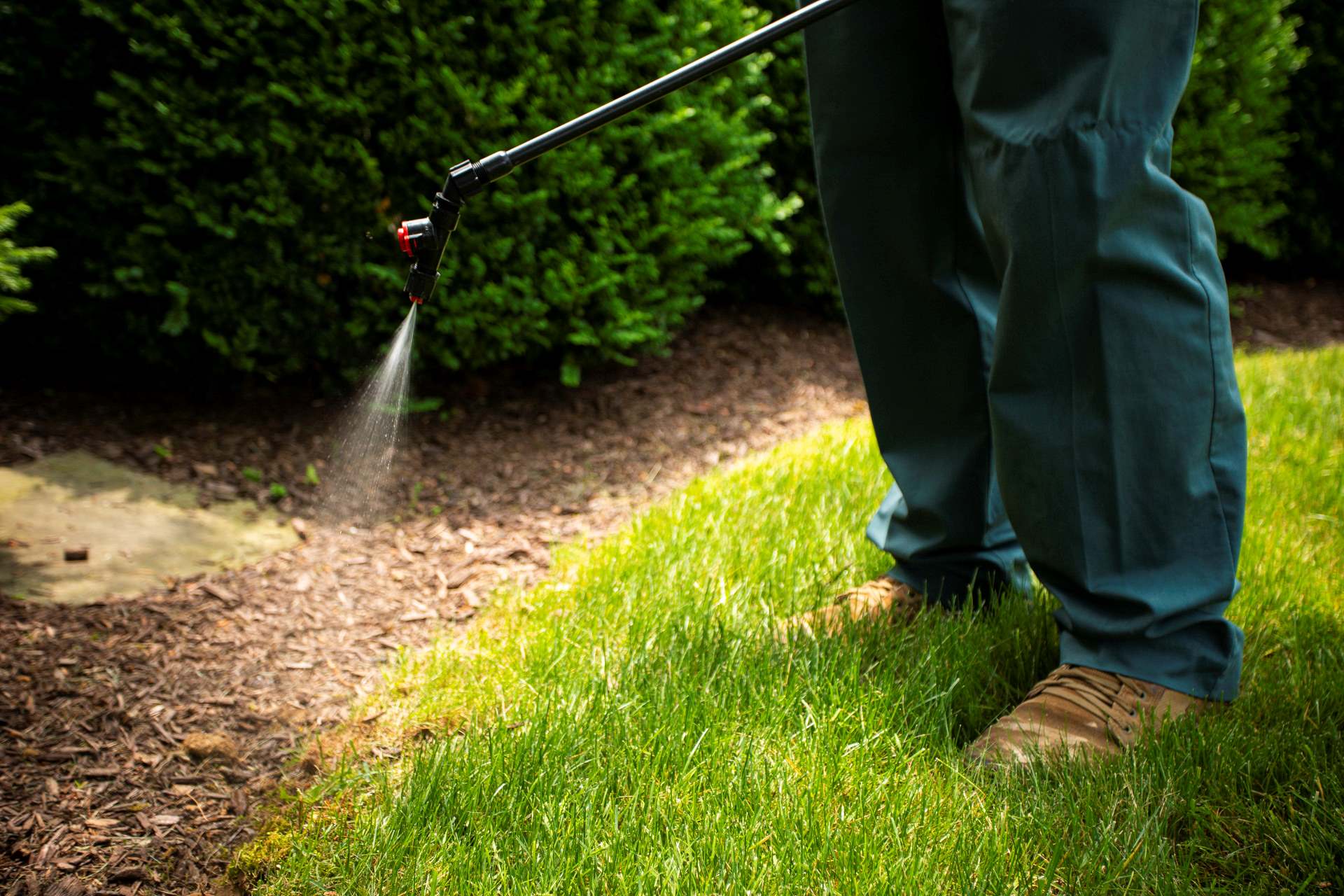Home>Types of Gardening>Ornamental Gardening>How Long After Planting New Grass Can You Spray For Weeds


Ornamental Gardening
How Long After Planting New Grass Can You Spray For Weeds
Modified: January 22, 2024
Learn when to safely spray for weeds after planting new grass in your ornamental garden. Find out the ideal timeline for weed control to maintain a healthy and vibrant lawn.
(Many of the links in this article redirect to a specific reviewed product. Your purchase of these products through affiliate links helps to generate commission for Chicagolandgardening.com, at no extra cost. Learn more)
Table of Contents
Introduction
Ornamental gardening is a captivating and rewarding endeavor, allowing individuals to cultivate beautiful landscapes and showcase their creative flair. From stunning flowering plants to lush green grass, creating an aesthetically pleasing garden requires careful planning and maintenance. One common challenge faced by gardeners is dealing with weeds that can harm the appearance and growth of their ornamental plants.
When it comes to maintaining a healthy garden, it is crucial to strike a balance between weed control and the well-being of newly planted grass. Many gardeners are often unsure about when they can start spraying for weeds after planting new grass. This article aims to shed light on this topic and provide helpful insights for effective weed control in ornamental gardening.
Successfully establishing new grass requires particular attention during the early stages of growth. It is important to give the grass adequate time to establish its root system before introducing herbicides for weed control. This waiting period ensures that the newly planted grass is well-established and can withstand the herbicidal treatment without damage.
In the following sections, we will explore the factors to consider when determining the waiting period for weed spraying, the different types of herbicides available, and valuable tips for effective weed control in newly planted grass. By understanding these aspects, you will be well-equipped to maintain a weed-free and visually stunning ornamental garden.
Factors to Consider
Before deciding when to spray for weeds after planting new grass, it is important to take into account several factors that can impact the success of your weed control efforts. Considering these factors will help ensure that the timing of weed spraying is appropriate and effective.
Type of grass: Different varieties of grass have varying growth rates and tolerance to herbicides. It is important to know the specific type of grass you have planted and its characteristics regarding herbicide sensitivity. Some types of grass may require a longer waiting period before weed spraying, while others may be more resilient and tolerate herbicides earlier in the growth process.
Grass maturity: Newly planted grass needs time to establish its root system and develop strong growth. It is crucial to allow the grass to reach a certain level of maturity before subjecting it to herbicides. This typically takes around 2-4 weeks depending on the grass species and environmental conditions.
Weather conditions: The weather plays a significant role in the success of weed control efforts. It is important to consider the current weather conditions and forecast before spraying for weeds. Extreme heat, drought, or heavy rainfall can negatively impact the effectiveness of herbicides. It is advisable to choose a time when the weather is mild, and there is no rain in the immediate forecast to ensure the herbicides have time to work without being washed away.
Pre-emergent or post-emergent herbicides: The type of herbicide you choose also affects the timing of weed spraying. Pre-emergent herbicides are applied before weeds germinate, while post-emergent herbicides are used after weeds have already sprouted. Understanding which type of herbicide you are using will help determine the appropriate timing for weed spraying and ensure optimal effectiveness.
Desired grass density: If you are aiming for a dense and healthy lawn, it is important to wait until the grass has reached the desired density before introducing herbicides. Allowing the grass to fill in gaps and establish a strong foothold will help prevent the growth of weeds and promote a uniform and lush appearance.
Considering these factors will help you determine the right timing for weed spraying after planting new grass. It is essential to give the grass adequate time to mature and establish its root system, while also considering the specific herbicides being used and the prevailing weather conditions. By carefully considering these factors, you can effectively control weeds without hindering the growth of your newly planted grass.
Waiting Periods for Weed Spraying
Once you have considered the various factors that impact weed control in newly planted grass, it is important to determine the waiting period before spraying for weeds. The waiting period allows the grass to establish its root system and reach a level of maturity that can withstand herbicidal treatment. The specific waiting period can vary depending on the grass type, herbicide type, and environmental conditions.
Newly seeded grass: If you have recently seeded your lawn with grass, it is important to wait until the grass has germinated and established its root system before applying any herbicides. Typically, you should wait for at least 4-6 weeks to allow the grass to grow strong and healthy. During this waiting period, manual weed control methods, such as hand-pulling or mowing, can be used to manage weed growth.
Sod or turf installation: If you have installed sod or turf to establish your lawn, it is recommended to wait at least 2-4 weeks before applying herbicides. This waiting period allows the sod to root firmly and ensures that it can withstand the herbicidal treatment. Before applying any herbicides, ensure that the sod has established a strong bond with the soil by gently tugging on a corner to check for resistance.
Herbicide label instructions: It is crucial to carefully read and follow the instructions provided on the herbicide label. Different herbicides may have specific waiting periods mentioned on their labels that should be followed to ensure proper effectiveness and safety. These waiting periods may vary depending on the brand, type of grass, and target weeds.
Environmental conditions: Apart from considering the growth stage of your grass, it is important to take into account the current environmental conditions before spraying for weeds. Extreme weather conditions, such as high temperatures or excessive rainfall, can impact the efficacy of herbicides. It is advisable to choose a calm day with moderate temperatures and avoid spraying if rain is expected within 24 to 48 hours.
By following these general waiting periods and considering the herbicide label instructions and environmental conditions, you can ensure the effective control of weeds without causing harm to your newly planted grass. It is always recommended to consult with a professional or seek guidance from local gardening experts for specific waiting periods tailored to your grass type and region.
Types of Herbicides
When it comes to weed control in ornamental gardening, there are various types of herbicides available. Understanding the different types can help you choose the most suitable option for your needs. It is important to select herbicides that target the specific weeds you are dealing with while being safe for your newly planted grass.
Pre-emergent herbicides: Pre-emergent herbicides are typically applied before weed seeds germinate. These herbicides create a barrier in the soil that prevents weed seeds from sprouting. They are effective in controlling annual weeds, such as crabgrass and chickweed, by stopping their growth before they become visible. Pre-emergent herbicides are best applied before or during the early stages of grass growth, following the waiting period mentioned earlier.
Post-emergent herbicides: Post-emergent herbicides are used to control weeds that have already sprouted and are actively growing. They target the leaves and stems of existing weeds, killing them by disrupting their growth and metabolic processes. Post-emergent herbicides can be selective or non-selective. Selective herbicides are formulated to target specific types of weeds while minimizing damage to the desirable grass. Non-selective herbicides, on the other hand, kill all plant material they come into contact with and should be used with caution around the newly planted grass.
Systemic herbicides: Systemic herbicides are absorbed by the foliage or roots of weeds and are translocated throughout the plant, reaching the underground parts, including the roots. This makes them effective in killing the entire weed, including the root system. Systemic herbicides are commonly used for perennial weeds that are difficult to control using other methods. However, caution should be exercised when using systemic herbicides around newly planted grass to avoid unintended damage to the grass roots.
Contact herbicides: Contact herbicides are formulated to kill weeds on contact, primarily affecting the parts of the weed that come into direct contact with the herbicide spray. They are generally fast-acting and provide immediate visible results. Contact herbicides are effective for controlling annual weeds and can be used as spot treatments without significant harm to the surrounding grass. However, they may not be as effective for perennial weeds with deep root systems.
Organic herbicides: For those who prefer organic gardening methods, there are herbicides available that are formulated using natural, plant-derived ingredients. These organic herbicides can be effective in controlling weeds without introducing synthetic chemicals into the environment. However, it is important to note that organic herbicides may still have specific waiting periods and precautions that need to be followed to protect newly planted grass.
Before using any herbicide, carefully read the label instructions, including the recommended waiting periods and precautions for newly planted grass. It is also advisable to consult with a gardening expert or local extension service to determine the most suitable herbicide for your specific needs and circumstances.
Weed Control Tips for Newly Planted Grass
Ensuring effective weed control in newly planted grass is crucial for establishing a healthy and vibrant lawn. Here are some practical tips to help you achieve successful weed management:
- Proper soil preparation: Before planting new grass, ensure that the soil is properly prepared. Remove any existing vegetation, rocks, or debris that may hinder the growth of the grass or create ideal conditions for weed seeds to germinate. Loosen the soil and amend it with organic matter to promote healthy root development and discourage weed growth.
- Choose high-quality grass seed or sod: Using high-quality grass seed or healthy sod will give your lawn a head start in competing against weeds. Select grass varieties that are well-adapted to your climate and soil conditions. High-quality grass will establish quickly and densely, reducing opportunities for weed growth.
- Maintain proper watering: Newly planted grass requires consistent watering to establish a strong root system. However, avoid overwatering as it can create favorable conditions for weed growth. Water deeply and less frequently to encourage deep root development and discourage shallow-rooted weeds.
- Monitor and remove weeds manually: Regularly inspect your lawn for any weeds that may have sprouted. Use hand-pulling or carefully dig out weeds, taking care not to disturb the newly planted grass. Be vigilant and remove any weeds before they have a chance to flower and spread their seeds.
- Mow at the correct height: Proper mowing practices are essential for weed control. Set your mower to the recommended height for your specific grass type. Cutting the grass too short can weaken it, allowing weeds to invade. Additionally, leaving the grass longer shades the soil, inhibiting weed seed germination.
- Avoid herbicides until the grass is established: As mentioned earlier, it is important to wait until the grass is well-established before using herbicides. Prioritize manual weed control techniques during this waiting period. Once the grass is established, follow the herbicide label instructions carefully to ensure effective weed control without causing harm to the grass.
- Promote healthy grass growth: A strong and healthy lawn is more resistant to weed invasion. Provide the grass with adequate nutrients through regular fertilization based on soil test recommendations. A well-fed lawn will outcompete weeds and establish a dense and healthy carpet of grass.
- Maintain proper lawn care practices: Consistent maintenance practices, such as regular mowing, watering, and fertilizing, contribute to a healthy lawn and play a vital role in weed prevention. A well-maintained lawn will have fewer bare spots or thin areas where weeds can take hold.
By following these weed control tips and taking proactive measures to promote a healthy grass environment, you can effectively minimize the growth of weeds in your newly planted lawn. Remember, patience and diligence are key when it comes to establishing a beautiful and weed-free garden.
Conclusion
Successfully controlling weeds in a newly planted grass area requires careful consideration of various factors, including grass type, herbicide type, and environmental conditions. By allowing the grass to establish its root system and reach a level of maturity, you can ensure that it can withstand herbicidal treatment without damage. Understanding the different types of herbicides available, such as pre-emergent and post-emergent herbicides, can help you choose the most appropriate option for your weed control needs.
It is important to follow the waiting periods suggested for new grass before applying herbicides and to carefully read and adhere to the instructions provided on the herbicide labels. Additionally, organic herbicide options are available for those who prefer to utilize natural alternatives. Consulting with gardening experts or local extension services can provide valuable guidance and tailored recommendations for your specific grass type and region.
Implementing proper soil preparation, selecting high-quality grass seed or sod, monitoring and removing weeds manually, maintaining proper watering and mowing practices, and promoting overall grass health through regular care are all vital elements of effective weed control. By following these tips, you can establish a healthy and visually appealing lawn while minimizing weed growth.
Remember, patience and consistency are key when it comes to weed control in newly planted grass. With proper planning, attention to detail, and regular maintenance, you can achieve a weed-free and beautiful ornamental garden that will be the envy of your neighbors.







